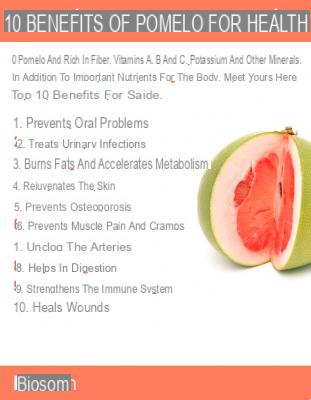
- What is pomelo?
- Properties and benefits of pomelo
- How to consume pomelo
- Nutritional values of pomelo
What is pomelo
Il pomelo, also known as pummelo, pampaleone or pampelmousse, is the fruit of Citrus maxima, a tree belonging to the Rutaceae family, originally from South East Asia and now grown in various areas for food purposes.
The pomelo tree produces hesperides, edible citrus fruits rich in water, fiber and vitamin C and is considered the ancestor of citrus fruits.
Although the name suggests a cross between grapefruit and apple tree, actually it is a non-hybridized species from which all the other citrus fruits derive, thanks to the crossing with mandarin, cedar and papeda.
Compared to other citrus fruits, the pomelo fruit is larger in size: in fact, it can weigh up to two kilograms and reach a diameter of 25 centimeters.
La crafts, then, it is not spherical like that of oranges and grapefruits but slightly elongated, similar to that of a pear. The peel of the pomelo has different shades, from pale green to intense yellow, according to the degree of ripeness.
The cloves of the pomelo, pulpy and rich in seeds, have a slightly acidic taste but much less acidic than lemon and bitter oranges.
From the pure variety of pomelo they derive numerous cultivars, which are distinguished by flavor and color of the pulp: the sweeter varieties, with a flavor similar to oranges, are characterized by white pulp, while the more sour ones have pink pulp whose taste is reminiscent of that of grapefruit.
Properties and benefits of pomelo
Pomelo is a fruit low in calories and rich in water, fiber and vitamin C, as well as sugars, beta-carotene, folic acid and mineral salts, especially potassium.
Thanks to the richness of water and fiber, consuming pomelo helps increase the sense of satiety and this, combined with the low caloric intake, make this fruit suitable for overweight and obese people.
Furthermore, the fibers present in pomelo help to modulate the absorption of glucose and cholesterol in the intestine and, in general, to improve bowel function, nourishing the microbiota and stimulating peristalsis.
Water and mineral salts, then, guarantee the right state of hydration to the body, therefore the consumption of pomelo can be useful for all people who tend to drink little water or who need to increase their fluid intake.
The high content of vitamin C and other substances fromantioxidant action make pomelo an ally against the damaging action of free radicals, as well as a remedy to improve the body's immune response.
How to consume pomelo
The pulp of the pomelo can be eaten raw after peeling the fruit, as in the case of all other citrus fruits.
In addition to enjoying pomelo as a fresh fruit, alone or in fruit salad, it is possible to obtain from this citrus fruit freshly squeezed and juices, as well as jams, jellies, slushes and ice creams.
The peel of the pomelo, rich in essential oils, on the other hand, it is used to flavor numerous sweet and savory dishes. The rind is often candied and covered with chocolate to dampen the bitter taste, or it is used to make pulp-free jams.
In the Asian regions the pomelo is the basis of the recipe of one alcoholic drink prepared with pomelo, brandy and honey.
Nutritional values of pomelo
Pomelo, as we have seen, contains few calories, high amounts of water, fiber, vitamin C and beta-carotene and is a good source of mineral salts, especially potassium.
Being a fruit, the pomelo is practically fat-free and protein and does not contain cholesterol.
Specifically, a 100-gram serving of pomelo provides the body with only 38 calories which essentially come from the 10 grams of carbohydrates present in it, of which 1 gram is represented by fiber.
The pomelo is considered one good source of vitamin C and potassium since it contains, respectively, 60 milligrams and 216 milligrams per 100 grams.
This fruit also contains 8 IU of beta-carotene, precursor of vitamin A, 6 mg of magnesium and 4 mg of calcium.


























